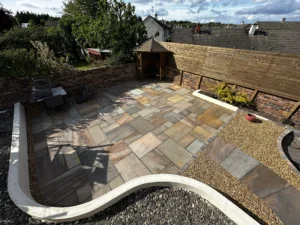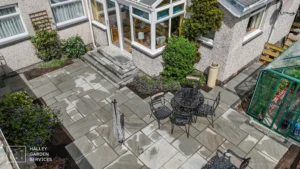Creating a garden that looks amazing in every season is the dream of many homeowners in the UK. With proper planning and the right approach to four-seasons landscaping, you can enjoy a beautiful outdoor space that changes and evolves throughout the year. This guide will show you how to design and maintain a garden that stays attractive from spring’s first blooms to winter’s quiet beauty.
Understanding the Basics of Year-Round Garden Design
A successful year-round garden starts with understanding what each season brings to your outdoor space. Each season has its own character, challenges, and opportunities. By planning for all four seasons, you create a garden that never feels empty or boring.
The key to all-seasons landscaping is choosing plants and features that offer something special in different months. This means thinking beyond just summer flowers and considering trees with interesting bark, plants with colourful winter stems, and shrubs that keep their leaves all year round.
When planning your garden, think about structure first. Evergreen plants, paths, and permanent features like benches or water features give your garden a backbone that looks good even when flowering plants are dormant.
Spring Landscaping: Awakening Your Garden
Spring landscaping is all about fresh starts and new growth. This is when your garden comes alive after winter’s rest. Spring landscaping focuses on awakening the garden with layers of colour, fragrance, and vibrant new foliage. Early spring bulbs like crocuses, daffodils, and tulips are essential for creating colour when most other plants are still sleeping.
Plan your spring garden to have waves of blooms. Start with early bulbs in February and March, then move to later spring flowers like bluebells and cherry blossoms in April and May. This creates a long season of interest rather than a short burst of colour.
Don’t forget about spring-flowering trees and shrubs. Magnolias, forsythia, and flowering cherries can become stunning focal points. These larger plants provide structure while adding spectacular seasonal colour.
Spring is also the perfect time for garden renovations. The mild weather makes it easier to work outdoors, and plants establish better when planted in spring’s moderate conditions.
Summer Landscaping: Peak Growing Season
Summer landscaping focuses on abundance and lush growth. This is when your garden reaches its full potential, with rich green foliage and vibrant flowers. Effective summer landscaping emphasises vibrant colours, smart plant choices, and thoughtful design to keep the garden both beautiful and manageable. Summer gardens need a good structure to handle all this growth without looking messy.
Choose a mix of annual and perennial flowers for continuous colour. Annuals like petunias, marigolds, and impatiens give non-stop blooms, while perennials like delphiniums, roses, and lavender provide reliable seasonal highlights.
Don’t overlook the importance of foliage plants in summer. Hostas, ferns, and ornamental grasses add texture and create cool, restful areas. These plants help balance the bright colours of summer flowers and provide structure when blooms fade.
Water features become especially valuable in summer. A small pond, fountain, or even a birdbath adds coolness and attracts wildlife to your garden. The sound of moving water also creates a relaxing atmosphere during hot summer days.
Autumn Landscaping: Spectacular Seasonal Colour
Autumn landscaping offers some of the most dramatic garden displays of the year. Fall colours can be absolutely stunning when planned correctly. This season is about celebrating change and preparing for winter’s rest. Autumn landscaping focuses on highlighting seasonal colour, texture, and harvest elements to create a warm and welcoming garden atmosphere.
Trees are the stars of autumn gardens. Maples, oak trees, and birches provide incredible leaf colour, while fruit trees offer both colourful leaves and attractive fruit. Even small gardens can include compact trees that deliver a big autumn impact.
Don’t forget about autumn-flowering plants. Chrysanthemums, asters, and autumn crocuses extend the flowering season well into fall. These late bloomers are especially valuable because they provide colour when many other plants are finishing their display.
Autumn is also harvest time if you grow any edible plants. Ornamental cabbages, colourful peppers, and late-season vegetables can be both practical and beautiful additions to your autumn garden display.
Winter Landscaping: Beauty in Simplicity
Many people think winter landscaping is impossible, but winter gardens can be surprisingly beautiful. This season is about appreciating subtle beauty, interesting textures, and the garden’s underlying structure. With thoughtful winter landscaping, you can transform even the coldest months into a season of elegance and charm.
Evergreen plants become the heroes of winter gardens. Conifers, holly, and evergreen shrubs provide colour and life when deciduous plants are bare. Choose evergreens with different textures, colours, and sizes to create visual interest.
Plants with colourful bark or interesting stems add drama to winter gardens. Red-twig dogwood, yellow-stemmed willow, and white birch bark create stunning displays against snow or winter skies. These plants prove that winter gardens can be just as exciting as summer ones.
Winter-flowering plants might seem impossible, but they do exist. Winter jasmine, witch hazel, and early camellias can bloom even in cold weather, providing unexpected colour during the darkest months.
Creating Structure with Hardscaping
Good garden fencing and permanent structures are essential for year-round garden success. Fences, walls, and screens provide a backdrop for plants and create structure that looks good in every season.
Paths and driveways in Edinburgh and Midlothian areas need to be both practical and attractive. Well-designed hard surfaces connect different garden areas and provide access even in wet weather. Choose materials that complement your home and look good year-round.
Garden structures like pergolas, arbours, and seating areas create focal points that work in all seasons. In summer, they support climbing plants. In winter, their bare structure adds architectural interest to the garden.
Maintaining Your Four-Seasons Garden
All seasons landscaping requires different maintenance approaches throughout the year. Spring means planting and pruning, summer focuses on watering and deadheading, autumn involves cleaning up and planting bulbs, while winter allows for planning and tool maintenance.
Professional garden services in Edinburgh and Midlothian can help maintain your year-round garden, especially with seasonal tasks that require expertise or special equipment.
Regular maintenance keeps your garden looking its best in every season. This includes seasonal pruning, appropriate feeding, and protecting tender plants during harsh weather. A well-maintained garden always looks better than a neglected one, regardless of the season.
According to the Royal Horticultural Society, proper seasonal garden care is essential for plant health and garden longevity. They recommend creating a seasonal calendar of garden tasks to ensure nothing gets forgotten.
Choosing Plants for Year-Round Interest
The secret to successful four-seasons landscaping lies in choosing the right plants. Look for plants that offer multiple seasons of interest. For example, a crab apple tree provides spring flowers, summer foliage, autumn fruit, and interesting winter bark.
Layer your plantings with trees, shrubs, perennials, and seasonal additions. This creates depth and ensures something is always looking good. Experienced landscape gardeners in Midlothian and Edinburgh understand this layering principle and can help you select the right plants for your specific conditions.
Consider maintenance requirements when choosing plants. Some high-maintenance plants might look stunning, but require more work than you want to commit to. Choose a mix of easy-care and special plants to keep your garden manageable.
Final Thoughts: Your Year-Round Garden Journey
Creating a successful four-seasons landscaping scheme takes time, patience, and planning, but the results are incredibly rewarding. A garden that looks good all year provides constant pleasure and significantly increases your property’s value.
Remember that gardens evolve over time. What you plant today will look different in five years, and that’s part of the joy of gardening. Start with a good structure, choose reliable plants, and add special touches as your garden matures.
The BBC Gardeners’ World magazine often features excellent examples of year-round gardens, providing ongoing inspiration for your own garden development.
With proper planning and care, your garden can be a source of beauty and pleasure throughout the entire year. Whether you’re admiring spring bulbs, enjoying summer abundance, celebrating autumn colours, or appreciating winter’s quiet beauty, a well-designed four-season garden provides endless rewards for you and your family to enjoy.
Frequently Asked Questions
Your local climate plays a key role in selecting plants that will thrive in each season. For example, a garden in the UK will need frost-resistant plants for winter, while warmer regions may focus more on heat-tolerant varieties in summer. Always check plant hardiness zones before buying.
Yes! Even in small spaces like balconies or patios, you can design for year-round interest using containers, vertical planters, and compact evergreens. Strategic use of colour, texture, and seasonal flowers in pots can transform small areas into vibrant year-round gardens.
Use a variety of plants that provide food and shelter through all seasons. Berry-producing shrubs, seed heads, and winter-blooming flowers attract birds and pollinators. Installing bird feeders, bee hotels, or small water sources also supports local wildlife throughout the year.
Use warm LED path lights, spotlights to highlight trees, and string lights for ambience. Solar-powered lights are eco-friendly and ideal for low-maintenance setups. Lighting makes your garden usable and visually appealing, even in darker months.






